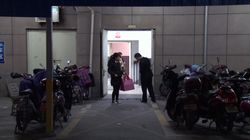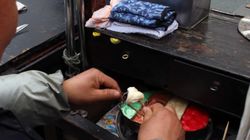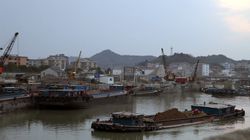Hangzhou|China
Statistical Data
Google entries for Hangzhou and 杭州 190.600.000
Google entries per inhabitant (city) 30.53
First written reference (as „Yuhang“) 220 v. C.
http://en.wikipedia.org/wiki/Hangzhou
Area
City 3.372 km²
Sub-provincial city 16.847 km²
Metropolitan area 34.585 km²
http://en.wikipedia.org/wiki/Hangzhou
POPULATION (2012)
City 6,24 million
Sub-provincial city 8,80 million
Metropolitan area 21,10 million
http://en.wikipedia.org/wiki/Hangzhou
Population Density
(inhabitants / km²)
City 1.851
Metropolitan area 610
Age structure (2008)
0 - 14 987.800
15 - 64 6.109.910
65+ 868.300
http://eng.hangzhou.gov.cn/main/zpd/English/AboutHangZhou/T305817.shtml
CLIMATE
Max. temperature Ø (°C) 20,7
Min. temperature Ø (°C) 12,9
Amount of rain / year (mm) 1.376
Days of rain / days 155
http://de.wikipedia.org/wiki/Hangzhou
ECONOMY
GDP 2008 66,95 billion USD [1]
GDP 2013 136,11 billion USD [2]
yearly rate of expansion (2008 - 2012) 13,7% [1]
GDP Metropolitan area (2011) 229.7 Mrd. USD [2]
GDP per Capita 2001 3.024 USD [3]
GDP per Capita 2013 15.467 USD [1]
[1] http://www.kpmg.com/CN/en/IssuesAndInsights/ArticlesPublications/Documents/Invest-Hangzhou-New-Energy-201305.pdf
[2] http://en.wikipedia.org/wiki/Hangzhou
[3] http://www.wtcsd.org/Resources/Documents/130730%20China%20TIPS.pdf
Share of the GDP, by sectors (2012)
Primary sector 3,3%
Secondary sector 46,5%
Tertiary sector 50,2%
http://www.chinaknowledge.com/CityInfo/City.aspx?Region=Coastal&City=Hangzhou
Private economy share of the GDP (2012) 59,7%
http://www.hzstats.gov.cn/web/shownews.aspx?id=QaVQ6opv1uQ=
Important economic sectors (GDP in Euro)
Bio-chemical industry 1,86 billion (2012) [1]
New Energy Sources 2,93 Mrd. (2012) [2]
Finance and insurance 8,52 billion (2011) [3]
Recreation and Tourism 16,20 billion (2012) [4]
Modern Equipment Manufacturing (e.g. transport, IT,
automatization) 54,57 Mrd. (2012) [5]
[1] http://www.kpmg.com/CN/en/IssuesAndInsights/ArticlesPublications/Documents/Invest-Hangzhou-Biochemical-industry-201305.pdf
[2] http://www.kpmg.com/CN/en/IssuesAndInsights/ArticlesPublications/Documents/Invest-Hangzhou-New-Energy-201305.pdf
[3] http://www.kpmg.com/CN/en/IssuesAndInsights/ArticlesPublications/Documents/Invest-Hangzhou-Financial-Service-Industry-201209.pdf
[4] http://www.kpmg.com/CN/en/IssuesAndInsights/ArticlesPublications/Documents/Invest-Hangzhou-Tourism-and-leisure-201305.pdf
[5] http://www.kpmg.com/CN/en/IssuesAndInsights/ArticlesPublications/Documents/Invest-Hangzhou-Modern-equipment-manufacturing-201304.pdf
Foreign direct investment in Euro
2007 2,09 billion
2009 3,02 billion
2012 3,60 billion
http://www.kpmg.com/CN/en/IssuesAndInsights/ArticlesPublications/Documents/Invest-Hangzhou-Modern-equipment-manufacturing-201304.pdf
TOURISM (2012)
Domestic tourists € 82,37 million
Foreign tourists € 13,31 million.
Turnover € 16,20 billion
http://www.chinaknowledge.com/CityInfo/City.aspx?Region=Coastal&City=Hangzhou
Special economic zones (GDP in 2010 in Euro)
Hangzhou Economic & Technological Development Zone 4,18 billion
Hangzhou Export Processing Zone 1,15 billion
Hangzhou Hi-tech Industrial Development Zone 3,98 billion
Hangzhou Xiaoshan Economic & Technological Development Zone 1,83 billion
Hangzhou Zhijiang National Tourist & Holiday Resort N.A.
http://china-trade-research.hktdc.com/business-news/article/Fast-Facts/Hangzhou-Zhejiang-City-Information/ff/en/1/1X000000/1X09WA60.htm
Alibaba (private E-commerce group. Company based in Hangzhou)
Estimated company value 55 - 120 billion USD
Employees (2012) 24.000
The eBay-like portal "Taobao" is one of 20 visited websites worldwide.
Trade volume of Taobao (2012) more than 160 billion USD. Sites belonging to the Alibaba group were responsible for more than 60% of all delivered packages in China.
http://en.wikipedia.org/wiki/Alibaba.com
LABOUR
Labour market (China, 2012)
Total population 1,35 billion
Population of employable age (15-59) 937 billion
thereof employed 767 million
thereof employed in the city area 371 million
http://www.clb.org.hk/en/view-resource-centre-content/100060
Employees in the city area per company proprietor (China, 2012)
Governement enterprises ca. 60 million.
Private enterprises ca. 69 million
Foreign company owners ca. 21 million
Self-employed small company owners ca. 52 million
http://www.clb.org.hk/en/view-resource-centre-content/100060
Migrant workers (China 2012)
Amount 262 million
thereof long distance 163 million
Age under 30 ca. 40%
41 - 50 ca. 25%
over 50 ca. 15%
About 40 percent of migrant workers are under 30 years old. Factory bosses have traditionally sought younger workers to stand on the production line, believing that they are more capable of performing long, tedious shifts, day in and day out. Moreover, young single workers can be housed in cheap, cramped on-site dormitories that are unsuitable for older employees with children. However, the declining birthrate in China has meant that fewer young people are entering the workforce, and those seeking jobs do not necessarily want to work in a factory. This has led to significant labour shortages in Guangdong and other coastal provinces, forcing employers to hire more workers in their 40s and 50s.
http://www.clb.org.hk/en/content/migrant-workers-and-their-children
Employees of migrant workers, by sector (China 2012)
Manufacturing industry 35%
Building industry 18%
Transport 6%
Commerce 10%
Hotel / Restaurant Industry 5%
Household and other Service Industries 12%
http://www.clb.org.hk/en/content/migrant-workers-and-their-children
Unemployment rate (Hangzhou, 2012) 1,63%
http://china-trade-research.hktdc.com/business-news/article/Fast-Facts/Hangzhou-Zhejiang-City-Information/ff/en/1/1X000000/1X09WA60.htm
Youth unemployment (China, 16-24 years old, 2012) 9,6%
http://www.cnbc.com/id/101433696?_ga=1.242392902.535194812.1397321319
Youth unemployment after educational qualification (China, 16-24 Jahre, 2012)
Primary education 4,2%
Junior High School 8,1%
Senior High 8,2%
Junior College 11,3%
University 16,4%
This observation is perhaps not that surprising; China’s economic miracle has been driven by three sectors: export-driven manufacturing, construction and large energy and capital intensive heavy industries dominated by the state, none of which offer large number of white-collar jobs suitable for university graduates. By contrast, low-skilled workers with a primary and junior secondary education, especially young migrants from rural China, can easily find jobs in the transportation, construction and catering industries. [...] Currently these businesses are finding it tough to recruit and retain workers as demand is high and supply is low. This, in turn, has led to the continuing increase in wages.
http://www.cnbc.com/id/101433696?_ga=1.242392902.535194812.1397321319
Employment situation of people with higher education (China, 2013)
Postgraduated total 6,9 million
Postraduated in Peking 229.000
Jobs for postgraduated in Peking 98.000
One report on graduate employment showed that as of April 2013, only 32 percent of graduates from the higher vocational schools 35 percent of those in undergraduate programmes and 26 percent of those in masters programmes had secured employment, all these rates were at least ten percent lower than in the 2012 figures. [...] Another survey in 2012 revealed that the monthly incomes of new graduates were basically comparable with those of migrant workers with a middle school education. The results showed that about 69 percent of graduates earned less than 2,000 yuan per month in their first job.
http://www.clb.org.hk/en/view-resource-centre-content/100060
Average available yearly income (China, 2013)
City Population 4.448 USD
Rural population 1.468 USD
http://www.bjreview.com.cn/nation/txt/2014-02/17/content_596909.htm
Average income (Hangzhou, 2013) 412,00 Euro
http://www.china-briefing.com/news/2013/11/19/average-wages-in-china-determining-minimum-and-maximum-social-insurance-contributions.html
Average income in the production industries (China)
2003 2.000 USD
2008 3.900 USD
2011 5.900 USD
http://qz.com/187350/six-charts-that-show-why-china-is-competing-with-the-multinationals-it-used-to-work-for/#/
Minimum wage (Hangzhou City Area, 2013)
Month 241 USD
Hour 1,97 USD
http://en.wikipedia.org/wiki/Minimum_wage_in_China
COST OF LIVING
Prices (in Euro)
12 eggs € 1.35
1 kg tomatoes € 1.14
Bread for 2 people for 1 day € 1.53
0,5 l beer in the supermarket € 1.14
1 l of whole fat milk € 1.89
Hourly rate for cleaning help € 2.56
Monthly rent for a 85 m2 flat
in an expensive area of the city € 599.00
1 l of gas € 0.87
Monthly ticket public transport € 9.00
http://www.expatistan.com
TRAFFIC
Motor Vehicles
Licenced Vehicles (2012) 2,4 million [1]
Average growth rate / year (2007-2012) 190% [1]
Extension of the traffic net / city (2007-2012) 2% [1]
Average speed during rush hour less than 20 km/h [2]
[1] http://www.ha.xinhuanet.com/hnxw/2012-08/06/c_112631804_2.htm
[2] http://www.bloomberg.com/news/2014-03-26/hangzhou-joins-growing-list-of-china-cities-with-limits-on-cars.html
Air quality according to the AQI (Air Qualty Index; 27.03.2014)
Average rate of 17 measuring stations 178
Lowest index 165
Highest index 198
Explanation of the index
Index value between 151 - 200 Unhealthy
Everyone may begin to experience health effects; members of sensitive groups may experience more serious health effects.
http://aqicn.org/map/hangzhou/
Limitation of motor vehicle licences
New licences (February 2013 - February 2014) 276.000 [1]
New licences after the limitation 80.000 [1]
thereof distribution via lottery 80% [1]
Distribution via auction 20% [1]
Initial first bit 1.628 USD [2]
[1] http://www.bloomberg.com/news/2014-03-26/hangzhou-joins-growing-list-of-china-cities-with-limits-on-cars.html
[2] http://usa.chinadaily.com.cn/china/2014-03/25/content_17378465.htm
Public Transportation
Metro
Opening November 2012
Lines 1 (2 more in construction)
City Net 48km
Scheduling until 2050 375km
Passengers / day ca. 210.000
http://de.wikipedia.org/wiki/Hangzhou_Metro
BRT-System (Bus Rapid Transit)
Lenght 55 km
Passangers / day (2012) 260.000
http://brtdata.org/#/location/asia/china/hangzhou
Bicycles
Hangzhou maintains the world wide biggest public bicyle programme 65.000 bicyles.
http://www.wri.org/blog/trillion-rmb-question-how-can-china-fund-its-sustainable-urban-transport-growth
Start 2008
Service Stations 2.674
Bicycles 65.000
http://www.hzbus.com.cn/en/about.aspx?c_kind=706&c_kind2=707&c_kind3=1078
Share of bicyles in public transport
1997 60,8%
2000 42,8%
2007 33,5%
http://76.12.4.249/artman2/uploads/1/China___s_Hangzhou_Public_Bicycle.pdf
Modal Share (2009)
Motor vehicles 13,7%
Public Transport 19,7%
Non-motor + E-Bikes 66,6%
http://www.unhabitat.org/downloads/docs/GRHS.2013.Case.Study.Hangzhou.China.pdf
Institutions
of Higher Education
38 Colleges and Universities with 120.000 postgraduates annually
http://www.kpmg.com/CN/en/IssuesAndInsights/ArticlesPublications/Documents/Invest-Hangzhou-Financial-Service-Industry-201209.pdf


































